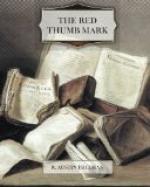Thorndyke now inked one of the stamps and handed it to the judge, who examined it curiously and then pressed it on a piece of waste paper, on which there immediately appeared a very distinct impression of a human thumb. “Marvellous!” he exclaimed. “Most ingenious! Too ingenious!” He chuckled softly and added, as he handed the stamp and the paper to the foreman of the jury: “It is well, Dr. Thorndyke, that you are on the side of law and order, for I am afraid that, if you were on the other side, you would be one too many for the police. Now, if you are ready, we will proceed. Will you, please, stamp an impression in square number three.”
Thorndyke drew a stamp from its compartment, inked it on the slab, and pressed it neatly on the square indicated, leaving there a sharp, clear thumb-print.
The process was repeated on nine other squares, a different stamp being used for each impression. The judge then marked the ten corresponding squares of the other two sheets of paper, and having checked them, directed the foreman to exhibit the sheet bearing the false thumb-prints to the jury, together with the marked sheet which they were to retain, to enable them to check the statements of the expert witnesses. When this was done, the prisoner was brought from the dock and stood beside the table. The judge looked with a curious and not unkindly interest at the handsome, manly fellow who stood charged with a crime so sordid and out of character with his appearance, and I felt, as I noted the look, that Reuben would, at least, be tried fairly on the evidence, without prejudice or even with some prepossession in his favour.
With the remaining part of the operation Thorndyke proceeded carefully and deliberately. The inking-slab was rolled afresh for each impression, and, after each, the thumb was cleansed with petrol and thoroughly dried; and when the process was completed and the prisoner led back to the dock, the twenty squares on the paper were occupied by twenty thumb-prints, which, to my eye, at any rate, were identical in character.
The judge sat for near upon a minute poring over this singular document with an expression half-way between a frown and a smile. At length, when we had all returned to our places, he directed the usher to bring in the witnesses.
I was amused to observe the change that had come over the experts in the short interval. The confident smile, the triumphant air of laying down a trump card, had vanished, and the expression of both was one of anxiety, not unmixed with apprehension. As Mr. Singleton advanced hesitatingly to the table, I recalled the words that he had uttered in his room at Scotland Yard; evidently his scheme of the game that was to end in an easy checkmate, had not included the move that had just been made.
“Mr. Singleton,” said the judge, “here is a paper on which there are twenty thumb-prints. Ten of them are genuine prints of the prisoner’s left thumb and ten are forgeries. Please examine them and note down in writing which are the true prints and which are the forgeries. When you have made your notes the paper will be handed to Mr. Nash.”




